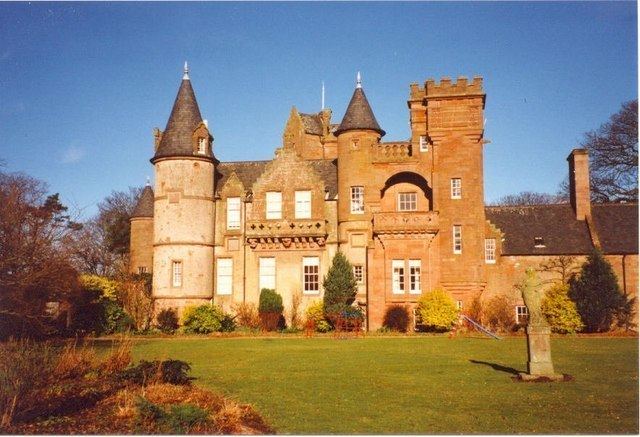Architectural style Scots Baronial Country Scotland Opened 1870 Construction started 1840 | Completed 1870 Phone +44 1241 656124 Architect Patrick Allan Fraser | |
 | ||
Similar Hospitalfield, Arbroath Abbey, Royal Scottish Academy, Signal Tower Museum, House of Dun Profiles | ||
Hospitalfield house
Hospitalfield House is an arts centre and historic house in Arbroath, Angus, Scotland regarded as "one of the finest country houses in Scotland". It is believed to be "Scotland's first school of fine art" and the first art college in Britain. A range of prominent Scottish artists have worked there, including Joan Eardley, Peter Howson, Will Maclean, Robert Colquhoun, Robert MacBryde, William Gear, Alasdair Gray, Wendy McMurdo, and Callum Innes.
Contents
- Hospitalfield house
- Hospitalfield house arbroath video montage december 2011
- Early History
- Patrick Allan Fraser 1812 90
- Present Day
- Exterior
- Interior
- References
Hospitalfield house arbroath video montage december 2011
Early History
Hospitalfield House was founded in the 13th century by Tironesian monks from nearby Arbroath Abbey as a leprosy and plague hospice called the "Hospital of St John the Baptist". It was purchased and extended by James Fraser in 1665. Walter Scott stayed in the house in 1803 and 1809 and used it as his model for 'Monkbarns' in his novel The Antiquary (1816).
See Hospital of St John the Baptist, Arbroath for a detailed account of the early history of the House together with sources.
Patrick Allan-Fraser (1812-90)
In the mid 19th century, Hospitalfield House was expanded by Patrick Allan-Fraser, a patron of the arts. Allan-Fraser, the son of an Arbroath weaving merchant, studied art in Edinburgh and was once president of the British Academy of Art in Rome. In Arbroath, he completed a series of paintings for an edition of Scott's The Antiquary. After acquiring the Hospitalfield estate through marriage he embarked on a substantial remodelling programme. His scheme used mainly local craftsmen and converted an eighteenth-century barn into a gallery, added a five-storey bartizan and a large wing. He had a keen interest in the arts and set up the Patrick Allan-Fraser of Hospitalfield Trust to support young artists. The building was bequeathed "for the promotion of Education in the Arts" on the death of Allan-Fraser in 1890, having no heirs to his estate.
Present Day
The house is now a residential art centre, music, and conference venue. It is open to the public for four open weekends a year and for other events, including afternoon tours on the first Wednesday of the month. In 2015 Hospitalfield curated and organised Graham Fagen (artist)'s exhibition for Scotland + Venice, a Collateral Event of the 56th International Art Exhibition – La Biennale di Venezia.
In 2008, it was used as a film location for the docu-drama "Children of the Dead End" starring Stephen Rea.
Exterior
The red sandstone building is in the Gothic style and draws on medieval domestic architecture. Allan-Fraser was heavily indebted to the Arts and Crafts Movement. This is evident in the design of the building which features crenallated parapets, Crow-stepped gables, and Oriel Windows. In 1901, a new studio block was added with north-west facing windows. A smaller room contains a skylight and there are yards for outdoor sculpture.
Interior
Allan-Fraser wanted to create an inspiring space for young artists and the interior displays a large collection of Victorian sculpture, paintings, and wood-carvings which are of "international importance". The interior design features include Romanesque dado arcading and a Hammerbeam roof. The main public rooms in the house are the dining room, picture gallery and adjoining cedar room and anteroom. Two 17th century tapestries were obtained in the 1870s for the first floor drawing room to reflect a passage in The Antiquary. Chandeliers inside the house were obtained from the Guildhall in Birmingham. The gallery contains armorial references to the Fraser family who owned the estate from 1665 and the Parrott family, of Hawkesbury Hall who joined the Fraser estate in the 19th century.
Allan-Fraser commissioned self-portraits from members of The Clique, an art group he had known as a young man. These included John Phillip, Augustus Egg, William Powell Frith, Henry O'Neil, and Edward Matthew Ward. 'The Trial of Effie Deans' (1840) by Robert Scott Lauder hangs on the main landing. A painting of Elizabeth Bowes-Lyon by James Peter Quinn hung in Hospitalfield's gallery during the Second World War. The library contains books dating from 16th to 19th centuries.
